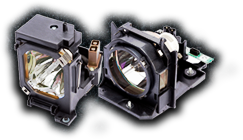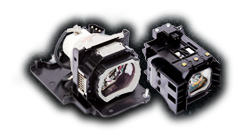Every time you replace your BenQ projector lamp, you must reset the lamp hour timer to zero. That way it can count upwards and lets you see the number of hours the lamp is used. To find out the lamp hours, follow these steps on the on-screen menu.
You need your projector turned on and warmed up, so you can view the image and have access to the on-screen menu.
- Press the [MENU/EXIT] button and then press < > (left and right arrows) until the System Setup: Advanced menu is highlighted. This will display the options within this sub-menu.
- Press the ▼to highlight the Lamp Settings in the left-hand navigation, and then press [MODE/ENTER]. This will display the Lamp Settings options.
- The lamp hours and additional information will be displayed under the Equivalent Lamp Hour tab.
Lamp Power Settings
There are 2 lamp power settings on your projector, which will extend the life of your lamp. Additionally, they will determine the level of brightness and lamp life with Economic and SmartEco modes.
Selecting the Economic mode will reduce system noise and power consumption by 30%, which will reduce brightness by 30% and may add 30% of life to your lamp.
Selecting SmartEco will reduce system noise and power consumption by 70%. This may add 70% of life to your lamp and reduce the brightness by 70%.
To activate Eco mode or SmartEco mode, press the [MENU/EXIT] button and then the < > arrows to navigate to the System Setup: Advanced menu. Next, select the Lamps Settings and then Lamp Power. Press the [MODE/ENTER] button and the Lamp Power options will be displayed. Press the ▲▼ arrows to navigate to the desired mode and then press [MODE/ENTER] to confirm your selection.
In the end, it’s up to you to decide which eco mode is better for your lamp and projector.
Another feature to consider to save the lamp life and protect your projector is the Auto Off setting. This will shut the projector off if there is no input source detected for a selected amount of time. The increments you can set are 5 – 30 minutes. For example, if you selected 5 minutes, then if there is no input source detected after 5 minutes, the projector will auto-shutoff.
The 3 Reminder Warnings
The first warning pops up “NOTICE: Order Replacement Lamp” if you exceed the Normal mode hours determined by BenQ, then you can select OK. If your projector is running on Normal mode, then you need to purchase a new lamp and replace it as soon as possible.
The 2nd warning pops up if you exceed the Eco Mode hours determined by BenQ, then you can select OK. If your projector is running in Eco mode, then you need to purchase a new lamp and replace it as soon as possible.
The 3rd warning pops up if you exceed what BenQ determines as the maximum number of hours under any given mode. Select the OK button. You must replace the projector lamp, so the projector can operate normally. The projector may auto-shut off once it reaches max hours. The only steps to resume functionality are to remove the existing lamp, replace it with a new lamp, and reset the lamp timer. Replacing the old lamp with a new lamp will give you a short period of time to quickly turn on the projector, go to the Menu, and reset the lamp timer.
Resetting the Lamp Timer
After replacing the lamp, you need to reset the lamp hours to zero. Technically, you can reset the hours on any lamp at any time. Resetting the lamp hours will turn off the Lamp Warning message on the on-screen menu once your existing lamp has reached its maximum hours.
First, make sure the lamp access panel door is attached and closed. The screw needs to be tightened but not over-tightened.
Then connect the power cord to the projector and turn on the projector by using the standby/power button.
After the start-up logo appears, press the [MENU/EXIT] button and then the < > (left and right arrows) until you select the System Setup: Advanced menu. This will display the sub-menu options.
Next, press the ▼ arrow to highlight the Lamp Settings and press the [MODE/ENTER] button to display the Lamp Settings sub-menu.
Lastly, highlight the Reset Lamp Timer using your arrow keys and press [MODE/ENTER]. A warning message will appear asking if you want to reset the lamp timer. Highlight the Reset using the up and down arrows and press [MODE/ENTER]. The lamp time will reset to “0”.


